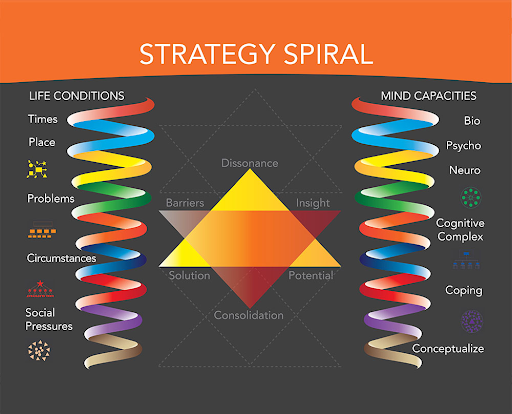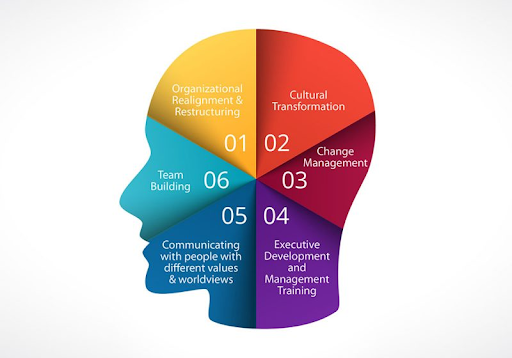Spiral Dynamics: Understanding People In Relation To Work
Are you a manager looking for new models of governance and team commitment? Keep reading to learn more regarding these topics.
Many of your peers are in the same boat – yet few take a people-centric approach to change. Without looking at the individual and their relationship to work and society, this is a boat that might sink.
The future of work can no longer evolve if it doesn’t look at people’s behavior.
Why do individuals act the way they do?
Can we model this behavior in order to develop it?
Daniel Eppling introduces the model of Spiral Dynamics. This is his interpretation of the different stages of an individual’s development.
Understanding Spiral Dynamics will help you understand your team’s behavior. It’ll help you foster more meaningful relationships with individuals who work for or with you. And even allow you to overcome tensions within your organization.
But don’t just take it from us. We’re going to look at this theory and unpack how you can leverage it to understand the people in your workforce.
What is Spiral Dynamics?
Spiral Dynamics is a framework used to chart societal development over time, depending on what society needs at that moment.
It’s a model used to understand the development between individuals, societies, and organizations.
Spiral Dynamics gives us a dual viewpoint:
- The sociological view (context).
- The psychological aspect (the person).
These two parameters describe a) the conditions of life and b) the mental capacity to deal with them.
The Spiral Dynamics model was based on the 1970s theories of psychologist Clare W. Graves, who identified eight ‘levels of existence'.
Disciples of Graves like Don Beck actually used this approach to advise politicians like Nelson Mandela or Tony Blair on how to view leadership and tackle societal challenges.
So what is this model all about?
How does Spiral Dynamics work?

Spiral Dynamics works in stages, alternating between an individual-focused worldview and a society-based one.
It is not so much a typology because the levels of existence are organized in sequence with each of them transcending and including the previous one.
Meaning, you can’t transcend to one phase without first going through another (hence the spiraling shape of the model).
Why does this matter to a manager?
Individuals on your team (and as society as a whole) will move through these stages depending on their contexts. As a manager, it’s important to use different tools as languages to understand your team.
Spiral dynamics will give you the language not only to understand the team but how individuals interact with your team and society (i.e., your organization) as a whole.
Let’s take a look at these stages.
What are the eight Spiral Dynamics levels?
1. 'Beige' / Instinctive
Everything starts with the dawn of humanity. Level 1 (beige) finds homo sapiens living in a natural and hostile world where it’s necessary to follow instincts and physiological imperatives to survive.
This level has now disappeared from our civilizations; only natural disasters such as a tsunami produce circumstances conducive to its manifestation.
2. 'Purple' / Animistic
This is a stage where humanity passes from 'I' to 'we'. The dominant perception is of a frightening world filled with mysterious powers and spirits.
This prompts people to seek security and call on elders, chiefs, and witchdoctors in order to live in harmony with the magic powers of nature. When we fall back on customs and traditions in which elders are consulted for their wisdom, as in Asia, we revert to this level of existence.
3. 'Red' / Egocentric
The 'ego' becomes more important than the 'group'. The more egocentric individual seeks to satisfy impulses without guilt, perceiving the world as a jungle where nature must be conquered.
The key issues are domination and power. Gaining respect and avoiding shame. Excessive acts of heroism are symbolized by the law of the strongest and immediate punishment. Corruption is a modern manifestation of this stage.
4. 'Blue' / Absolutistic
This period started several thousand years before Christ with the belief in a world controlled by an ultimate truth that punishes and rewards.
The 'ego' is once again sacrificed in return for later reward; impulses are controlled to live according to 'The Book' with its accompanying laws, rules, and figures of authority.
This is the context that gives rise first to religious and then to political 'isms'. This stage brings stability, loyalty, and the need for a sense of human existence and still represents around 30% of the population and power in western countries. In these organizations, the leader is irreplaceable and the hierarchy well organized, with procedures that govern everything.
5. 'Orange' / Multiplistic
We return to the 'I' mode where individuals seek success, influence, and status. This is typical of a world full of resources and opportunities to create a more prosperous life.
The ego takes a more individualist and calculated form to avoid triggering aggression by others. Quest for autonomy, independence, abundance, understanding the rational world, change, and progress through technology, striving to be the best. In the ‘orange’ stage everything is negotiable. 30% of the population and 50% of the power is focused on this level.
6. 'Green' / Relativistic
When individualist hyper-consumers of the orange stage become sated they reinvest in emotions, humanity, and spirituality. The world is then perceived as the shared habitat of humanity.
This involves seeking links, putting the 'ego' to one side, and living in equality and harmony with others. The release from greed and exploitation leads to interior exploration – a quest for global benefits for the community, a call for collective thinking, and greater sharing of leadership are typical of this stage.
The difficulty with the 'green' level may lie in its inability to sustain itself without being labeled as naive, or torpedoed by 'oranges' greedy to profit from it. Even though the population in this paradigm is increasing, its power represents only 15%.
7. 'Yellow' / Systemic
Level 7 (yellow) is less than 30 years old and already accounts for 5% of the population and power. It emerged with the systemic theories in the 1970s. According to Graves, this level marks a break because it incorporates all the previous stages.
The world is perceived as a set of complex systems beset with uncertainty whose viability must be ensured. Because the emotions of the 'green' group have become too onerous, they are substituted by knowledge and the need to obtain tangible results. Thinking becomes truly systemic and natural laws are seen as inevitable. This stage gives priority to flexibility and open systems, accepting paradoxes and complexity within a holistic view of the world.
8. 'Turquoise' / Holistic
The last level identified is still at an embryonic stage. The world appears as a network of interdependent components forming a single large organism. At this level, the quest is for global harmony. Since it has not yet penetrated organizations, we shall go no further at this stage...
More on the Turquoise Spiral Dynamic Stage
If you have a curious nature, you’re probably wondering about this turquoise spiral dynamics stage.
What’s important to remember is that we aren’t there yet, and it’s not because humans don’t need this stage, but because society as a whole isn’t there yet.
The turquoise stage means placing emphasis on the collective ‘we’ over ‘I’. There are certain ways you could start by doing this, in effect transitioning into a guru, teacher, or visionary.
Translating this turquoise stage into your organization might mean going from managing to leading.
According to Alex Hickman, “they may also build and guide their communities”. One training consultant at Krauthammer supports this saying:
Leadership is all about engaging and motivating others. It’s about being a team coach rather than a mere manager. (Szymon Rompczyk – Krauthammer consultant)
The beauty of Spiral Dynamics is that we’re currently operating (as a society) in more of an orange stage. And yet, we’re seeing movement towards an empathetic and human-centered stage (green). To embody the turquoise phase as a leader, it’s important you recognize the stages that come before.
Society isn’t at the stage where we need turquoise leaders. And your organization and the individuals on your team might not be either. Instead, what they might need more (reflected in the way they interact with their work and your company) could be guidance, empathy, and collaboration.
What are the potential business applications of Spiral Dynamics?
We believe that practice makes a behavior more conscious. Which is why we always start with theory – such as Spiral Dynamics – and continue with training, role-playing, and follow-through to see how this is actually applied in real-life.
So while this model may seem theoretical, there are actually many ways you can apply your learnings to your business development.
Spiral Dynamics provides keys to understanding shifting values within an organization.
Meaning, it’s not rare to find three or more levels cohabiting. Which is dominant? What are the consequences for organizational modes and the perception of the role of a leader?
What style of communication is used in dealings with customers or when promoting products? How can we best understand traditional multicultural dimensions through this prism (hierarchical distance, individualism, etc.)?
If you wish to dig deeper into the issues relating to this tool, contact deppling@krauthammerpartners.com
Conclusion
Organizations reflect levels of change, and if you can’t change with them as a manager or leader, then it’ll be difficult to contribute to the future of work.
Leveraging Spiral Dynamics will help you understand why people think and act in a certain way.
With that, people reflect the stage of your organization. Understanding what stage your organization is operating at will inform the mindset of your team, and even your own leadership mindset.
It’s a theory that, if applied and trained, can help you connect your team and become a successful leader.
Future-proofing your management style
These new leadership and management challenges may be frustrating to handle all at once.
But they also provide a unique opportunity for you to adapt your leadership approach now to increase the chances of success tomorrow.
We may be living through a highly challenging decade. But at Krauthammer, we strongly believe that leaders can learn from it, grow from it, and use it as a driving force behind their excellence.



.png?width=600&name=The%20Ultimate%20Guide%20to%20Adapting%20Your%20Sales%20Process%20to%20Incorporate%20Remote%20Sales%20and%20Energise%20Your%20Team%20to%20Boost%20Results%20(1).png)